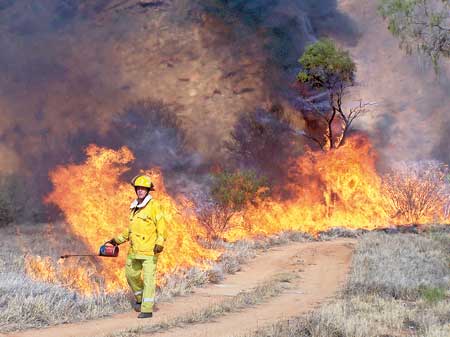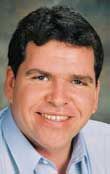Carbon farming for Top End, not The Centre as yet
14 July 2014
Archived article
 By ERWIN CHLANDA
By ERWIN CHLANDA
The national head office of the Aboriginal Carbon Fund (ACF) is located in Alice Springs but any benefits from it to The Centre are some way off.
The main method – there are 12 – of earning money through carbon farming is savannah burning. At present The Centre is excluded because there is “no rangelands methodology as yet,” says ACF General Manager Rowan Foley.
The scheme is limited to areas with 1000mm or more of rainfall a year which are generally north of Katherine.
Through selling the credits to industry, Indigenous groups in the Kimberley stand to generate about $5.3 million at the current spot price of $23.30 a tonne, says Nolan Hunter, CEO of the Kimberley Land Council.
But North Kimberley traditional owners are saying in a media release they “stand to lose millions of dollars if the carbon price is repealed and proposed changes to the Carbon Farming Initiative stops Aboriginal participation in the carbon market” under the Federal Government’s proposed Direct Action Plan.
Jeremy Dore, in charge of ACF Project Development and Legal, says: “At the moment, there is the Carbon Farming Initiative for land projects and the carbon price for industry.
“It is voluntary to undertake land projects like savanna burning under the CFI but paying the carbon price is mandatory for 351 large polluters.
“These companies can buy credits from CFI projects if they wish or just pay the government.
“Under the Government’s new approach, the carbon price will be repealed and changes to the CFI will be made to implement the Emissions Reduction Fund for the Government to buy credits (instead of companies under the carbon price),” says Mr Dore.
“CFI amendments also include a proposed ‘safeguard’ system to stop the largest 130 polluters going over ‘baseline’ emissions.
“The baselines will not be determined until next year and whether companies might have to pay or purchase credits for going over is unclear.
“The Government has not budgeted any revenue from this.”
The price polluters will pay for the credits will be set by a kind of reverse auction, says Mr Foley: producers will compete against each other to fill the demand for credits.
Where that price will go, in the auction system of the ERF being set up right now and due to come into effect this year, is anyone’s guess, says Mr Foley. But if it drops below $15 it will become uneconomical: costs for labor and machinery would not be fully covered.
Says Mr Hunter: “The proposal to sell carbon credits using a reverse auction method, where the cheapest price wins, will make Aboriginal participation in the carbon market completely unviable.
“The reverse auction is great for government and rewards big companies but it locks out small businesses and does not factor in the environmental, social and cultural co-benefits that Indigenous carbon projects provide.’’
How the system works in the bush is quite simple: “Cool season burning” of the savannah, while the grass is still young, short and contains some moisture, emits a lot less CO2 than when it is ignited, usually by lightning strike, at the height of its growth.
The difference between the cool burn emissions, and those of a “hot” burn, is what the producers – the people managing the burning – can sell as carbon credits.
Mr Foley says there is no “approved method” yet for dealing with the savage wildfires in The Centre because we don’t have savannahs but rangelands, and rangelands are not yet covered by the scheme.
The emissions from a rangeland wildfire, of course, are equally pernicious, and in recent years of high fuel loads there have been disastrous wildfires here. This year is tipped to be another one.
 It’s likely the scheme will be extended to the area with 600mm plus of rainfall, about north of Elliott, and it will take a couple of years to deal with The Centre which has 300mm, says Mr Foley (pictured at left).
It’s likely the scheme will be extended to the area with 600mm plus of rainfall, about north of Elliott, and it will take a couple of years to deal with The Centre which has 300mm, says Mr Foley (pictured at left).
Nation wide, sales of 400,000 tonnes from 11 savannah projects have been made.
Tree projects are under way in Far North Queensland, says Mr Foley. Producers get paid for the CO2 their trees absorb.
The ACF website also refers to “co-benefits” from projects, in addition to money for carbon credits.
The market may choose to pay a higher price for projects “delivering more benefits which may involve helping to protect a sacred site through appropriate fire management practices, employing local traditional owners as rangers, encouraging the re-introduction of rare or endangered wildlife or simply enabling people to be on country so the younger generation can learn from their elders.
“Most buyers will be extremely interested in this bigger story,” says the website, clearly because these buyers would be regarded as good corporate citizens and benefactors.
“For example, the Fish River savanna project, run by the Indigenous Land Corporation, sold their first credits to Caltex, who were interested in a project with traditional owners contributing to the production of the carbon credits.”
The ACF has a second office in Melbourne and “presence” in Broome, Perth, Darwin, Tennant Creek, Georgetown, Cairns, Ingham, Townsville, Rockhampton, Dubbo, Sydney, Canberra and Adelaide.
Mr Foley comes from the Badtjala people, traditional owners of Fraser Island, and has 25 years experience in the conservation and land management sectors.
Trained as a ranger he was the manager of the Uluru – Kata Tjuta National Park for three years before moving to Alice Springs.


